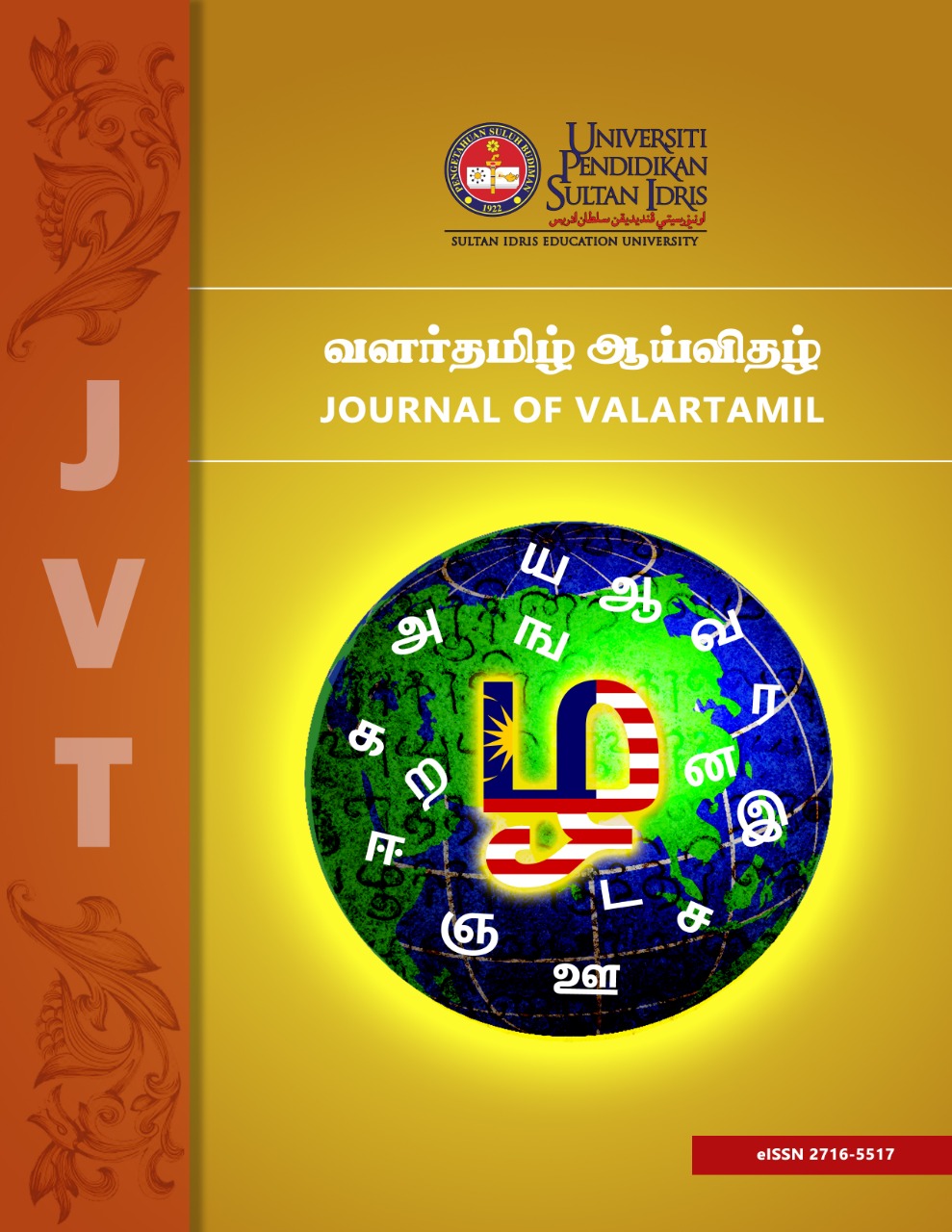Goddess Kali in Malaysian Tamil Folk Songs
DOI:
https://doi.org/10.37134/jvt.vol4.2.3.2023Keywords:
Goddess Kali, Mother Goddesses, Malaysia, Tamil Folk SongsAbstract
This study is to discover about Mother Goddesses in Tamil background, history of Goddess Kali and Goddess Kali in Malaysian Tamil folk songs. Qualitative approaches with narrative and descriptive designs were used for this study. The researcher used multiple sources as journals and books to analyse informations about Goddess Kali. Findings about Goddess Kali from Malaysian Tamil folk songs were described under seven titles.
Downloads
References
Arumugam, H., & Subramaniam, M. (2014). An evaluation of literature related to the phenomenon of building Shrines within the residence compound among Malaysian Indians. Journal of Indian Culture and Civilization, 59-68. https://eprints.um.edu.my/14468/1/0001.pdf
Chakravarty, S. (2017). Kali, Untamed Goddess Power and Unleashed Sexuality: A Study of the ‘Kalika Purana’ of Bengal. Journal of Asian Research, 1(1), 1-13. https://core.ac.uk/download/pdf/268086184.pdf
Chermanathan, P. (2012). Vaithamanithi Perumal Temple, Thirukolur-A Historical Study (Doctoral Thesis, Manonmaniam Sundaranar University, Thirunelveli, India). https://shodhganga.inflibnet.ac.in/handle/10603/133922
Clothey, Fred, W. (2006). Ritualizing the Boundaries: Continuity and Innovation in Tamil Diaspora.University of South Carolina Press.
Dupuche, J, R. (2012). The Goddess Kali and the Virgin Mary.Australian Ejournal of Theology, 19(1), 1-15. https://www.academia.edu/70961658/The_Goddess_Kali_and_the_Virgin_Mr
Hindhuja, J, R, & Parameswari, K. (2020). Early Hindu Temples in Malaysia and their Types, Journal of Tamil Peraivu, 9(1), 60-69. https://doi.org/10.22452/JTP.vol9no1.6
Ilango,N. (2020). Pazhanthamizhar Por Marabum Kotravai Vazhipaadum (War Ethics and Kortavai Worship Among Ancient Tamils). Keetru. https://www.keetru.com/index.php/2018-01-12-05-57-50/2014-03-08-04-39-26/2014-03-14-11-17-85/39970-2020-03-30-04-43-14
Jeya V, D.C & Anju, M. (2018). The Village Deity of Tamil Nadu: A Case Study of Maariyamman’s Myth. International Journal of Research Culture Society, 2(6), 79-81. https://issuu.com/editorijrcs/docs/201806017
Kanagaraju,K.(2019).Tholliyal Paarvaiyil Maanidaviyal (Anthropology in the Light of Archaeology). International Journal of Tamil Language and Literary Studies, 1 (1), 125-129. http://ijtlls.com/data/uploads/special-issue-1/22.%20KANAGARAJI.pdf
Kandasamy, S. (2019). Festivals and Religious Practices of Melaka Chetties among Malaysian Tamils. Journal Of Tamil Peraivu,8(2), 152-159. https://tamilperaivu.um.edu.my/article/view/21343
Kandiah, N, S. (1938). Kaliṅkattupparaṇi vacaṉam.Āciriyar nūṟpatippuk kaḻakam.
Keshigan, P. (2015). Kaliṅkattupparaṇi mūlamum uraiyum. Saradha Publications.
Manimaran, S., Sivapalan, G., & Rajantheran, M. (2016). Origin and the Development of Family Deity Worship Among Malaysian Tamils, Journal of Tamil Peraivu,, 4(1), 40-50. https://tamilperaivu.um.edu.my/article/view/14137
Marsman, M, A. (2019).Kali: In Praise of the Goddess.Psychological Perspective, 62, (2-3), 184-192. https://doi.org/10.1080/00332925.2019.1624445
Mariyappan,K.(2017). Sivagiri Mavadda Chirudeiva Vazhipaadu (Folk Deity Worship in Sivagiri District). (Doctoral Thesis, Manonmania Sundranar University, Thirunelveli, India). https://shodhganga.inflibnet.ac.in/handle/10603/244222
Padma. (2013). Vicissitudes of the Goddess: Reconstructions of the Gramadevata in India’s Religious Traditions. New York: Oxford University Press.
Pandey,A.(2016). Woman as Goddess in Indian Art. International Journal of Research – Granthaalayah, 4(3), 205-208. file:///C:/Users/HP/Downloads/24_IJRG16_B03_31.pdf
Parameswari, K. (2020). Sejarah Perkembangan Awal Kuil Batu Caves. https://www.researchgate.net/publication/341821012_SEJARAH_PERKEMBANGAN_AWAL_KUIL_BATU_CAVES_Parameswari_krishnan_Abstrak.
Sabapathy, V. (2015). The identity of the Malaysian Tamils in the Tamil Short Stories of Malaysia. Journal of Tamil Peraivu, 1(1), 42-52. https://ijie.um.edu.my/index.php/tamilperaivu/article/view/12666
Samy,P.L. (2011). Sanga Ilakkiyattil Thaai Theiva Vazhipaadu (Mother Goddess Worship in Sangam Literature). Chennai: P.R.V Press.
Sapkota, J. (2013). The Iconography of Divinity:Kali as a power-cluster of ten different goddesses. Crossing the Border: International Journal of Interdisciplinary Studies, 1(1), 11-20. file:///C:/Users/HP/Downloads/8515.pdf
Selvakkesavaraya Mudhaliyar. (1915). Cayaṅkoṇṭār kaliṅkattup paraṇi. Ki.Ka.Vu caṅkattār accukkūṭam.
Sritharan. (2000). ampaṉ māriyam'maṉ ālayaṉ (eṉa vaḻaṅkiya - vaḻaṅkum) tillai kāḷi am'maṉ kōvil. Dharani Computer Printers.
Stephen G.Lewis.(2016). Goddesses in the Hindu Tradition. Marburg Journal of Religion, 18(1), 1-18. file:///C:/Users/HP/Downloads/3528-Article%20Text-10503-1-10-20160602.pdf
Suppureddiyar, N. (1962). Aṟivukku viruntu.Tirunelvēli teṉṉintiya caivacittānta nūṟpatippuk kaḻakam, limited.
Thandayutam,R.(1998). Malēciya nāṭṭuppuṟap pāṭalkaḷ. Maṉo printers.
Vasanthakumar, S. (2017). Koṟṟavai vaḻippāṭum vaḷarcciyum.Multidisplicinary Journal of Aaytha Eluttu, 80-83. http://pallavipathippakam.com/wp-ontent/uploads/2021/07/3%AF%8D%E0%AE%B1%E0%AE%.pdf
Downloads
Published
Issue
Section
License
Copyright (c) 2023 Dhilip Kumar Agilan

This work is licensed under a Creative Commons Attribution-NonCommercial-ShareAlike 4.0 International License.





